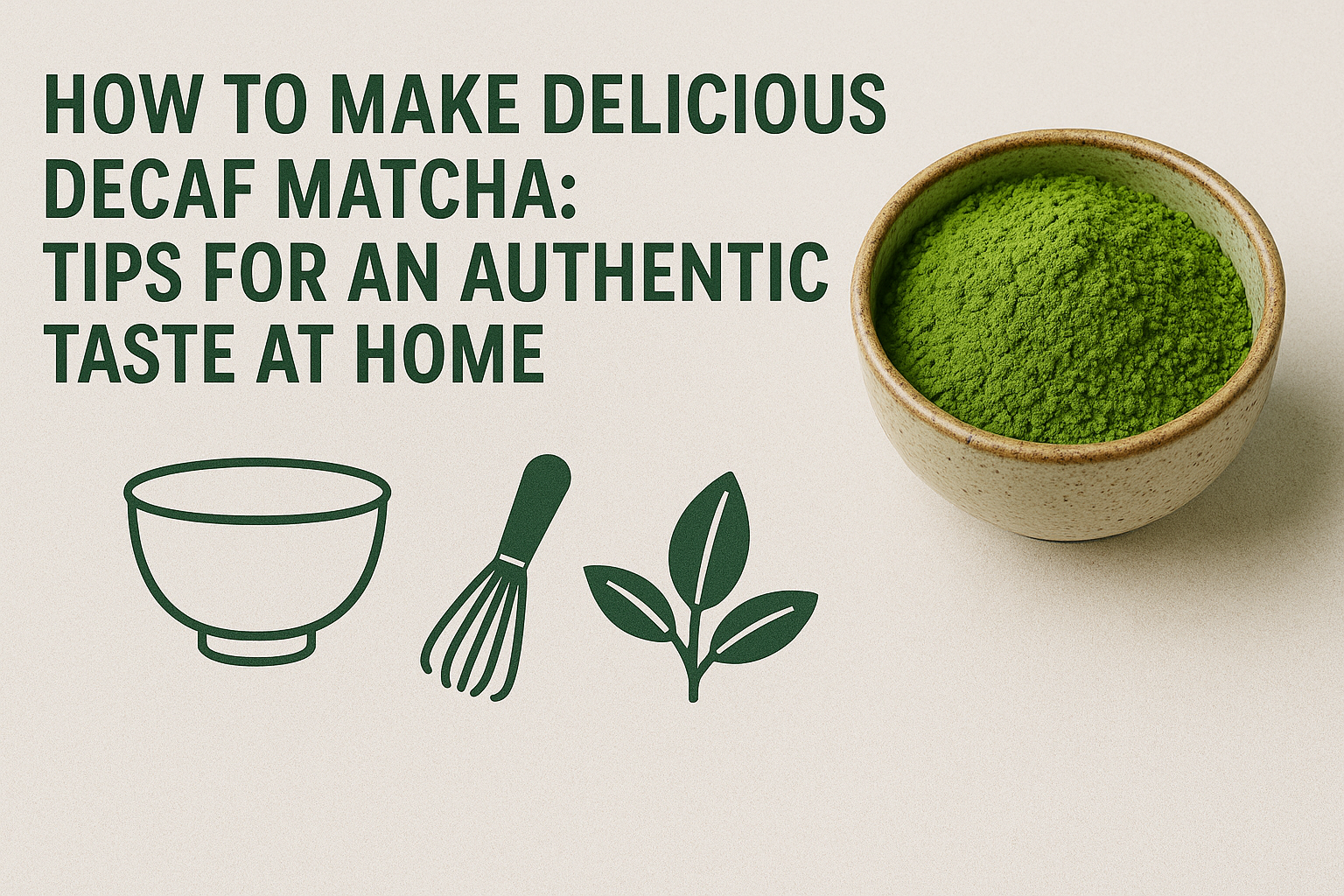- Your Guide to Delicious Decaf Matcha
- So, What Is Decaf Matcha?
- The Only Tools You’ll Need
- How to Make Perfect Decaf Matcha: A Simple Guide
- Tip: How to Get a Smooth, Clump-Free Finish
- What’s the Perfect Water Temperature?
- The Secret to Perfect Froth
- More Fun Ways to Enjoy Decaf Matcha
- How to Choose a Great Decaf Matcha
- How to Keep Your Matcha Fresh
- You’re Ready to Enjoy Decaf Matcha!
Your Guide to Delicious Decaf Matcha
Imagine enjoying the rich, authentic flavor of matcha any time you want, without a single worry about caffeine. That’s the magic of decaf matcha! It’s the perfect choice for a relaxing evening or for anyone who’s sensitive to caffeine. At first, making matcha might seem a little tricky, but we promise it’s not. Once you learn a few simple tricks, you’ll be whipping up surprisingly delicious cups like a pro. This guide will walk you through everything, step-by-step, so you can easily make the perfect decaf matcha at home.

So, What Is Decaf Matcha?
Just as the name says, decaf matcha is real matcha powder with the caffeine gently removed. Using special techniques, only the caffeine is filtered out, leaving all the good stuff behind. That means you still get the health benefits from components like L-theanine—the source of matcha’s signature savory umami taste—and powerful catechins. The biggest difference is that you won’t get the buzz from caffeine, so you can truly relax and enjoy the flavor and calming ritual of matcha whenever you like. While the taste can be a little milder, the best decaf matcha has a deep, satisfying flavor that rivals the regular kind.
The Only Tools You’ll Need
To make truly great matcha, having a few basic tools makes all the difference. Think of them as your matcha-making kit! First is a matcha bowl (chawan). A nice, deep bowl gives you plenty of room to whisk. Next, the most important tool: a bamboo whisk, called a chasen. This is what creates that beautiful, creamy foam. A chashaku, a small bamboo scoop, is perfect for measuring your matcha powder. Finally, a tea strainer or small sifter is your secret weapon against clumps. You can easily find these tools at tea shops or online.
How to Make Perfect Decaf Matcha: A Simple Guide
Got your tools? Let’s make some matcha! Just follow these steps, and you can’t go wrong.
1. Warm your bowl: Pour some hot water into your matcha bowl. Let it sit for a moment to warm up, then pour the water out and dry the bowl with a cloth. This keeps your matcha from getting cold too quickly.
2. Sift the matcha: Use your chashaku to measure one and a half to two scoops of decaf matcha. Sift it through your tea strainer directly into the warm bowl. This simple step is the key to a silky-smooth drink!
3. Add water: Pour about 70ml (2.4 oz) of hot water over the matcha powder.
4. Whisk it up: Now for the fun part! Using your chasen, whisk quickly with your wrist. First, mix the powder at the bottom, then move your whisk back and forth in a fast “W” shape. When a creamy layer of foam covers the top, you’re done!
Tip: How to Get a Smooth, Clump-Free Finish
Nobody likes lumpy matcha! Those little clumps (called dama in Japanese) can happen when the fine powder doesn’t fully dissolve. The easiest way to avoid them is to always sift your matcha powder through a strainer before adding water. The powder is so fine that it can stick together, but sifting makes it light and airy so it mixes perfectly. No strainer? No problem! Just put the matcha in your bowl, add a tiny bit of water, and mix it into a paste before adding the rest of the water. This extra step guarantees a beautifully smooth cup every time.
What’s the Perfect Water Temperature?
Getting the water temperature right is the key to unlocking the best flavor. If the water is too hot, it can scorch the delicate matcha, making it taste bitter. If it’s too cool, you won’t get that rich aroma and savory umami taste. The sweet spot is between 70°C and 80°C (160°F to 175°F). An easy trick is to boil your water, then pour it into a separate cup to let it cool down for a minute. This simple step helps bring out the natural sweetness of your matcha for a perfectly balanced flavor.
The Secret to Perfect Froth
That beautiful layer of foam is what makes matcha so special. The secret is all in how you use your bamboo whisk (chasen). Before you start, dip the tips of the whisk in hot water for a few seconds to make them soft and flexible. Once you’ve added the hot water to your bowl, hold the whisk straight up and down. Start by gently mixing to dissolve any powder on the bottom. Then, using just your wrist, whisk back and forth in a quick “W” or “M” motion. You’re not trying to scrape the bottom—just froth up the liquid. When the top is covered in a creamy foam, gently swirl the whisk in the shape of the Japanese character “no” (の) to make the foam even, then lift it from the center. Perfect!
More Fun Ways to Enjoy Decaf Matcha
Once you’ve mastered the classic cup, you can get creative! One of the most popular recipes is a decaf matcha latte. Just make a slightly stronger bowl of matcha, then pour in your favorite warmed milk (dairy, soy, or almond all work great!). Add a little honey or maple syrup if you like it sweet. On a hot day, pour it over ice for a cool treat. You can also sprinkle decaf matcha powder over vanilla ice cream for an instant, elegant dessert. The possibilities are endless!
How to Choose a Great Decaf Matcha
With so many options, how do you pick a good decaf matcha? Here are a few things to look for. First, check the color. You want a vibrant, bright green, which is a sign of freshness and quality. If it looks yellowish or brown, it might be old or lower grade. Next, check the origin. Matcha from famous Japanese regions like Uji (Kyoto) or Nishio (Aichi) is known for being top-notch. Finally, see if the package mentions the decaffeination method. A process called “Supercritical CO2 Extraction” is a great sign, as it preserves the flavor beautifully. When you’re starting out, buying a smaller package is a great way to find a brand you love.
How to Keep Your Matcha Fresh
Decaf matcha is delicate, so proper storage is key to keeping it tasting great. Its biggest enemies are humidity, light, heat, and smells. After opening the package, move the powder into an airtight container, like a tea canister or a sealed bag. The best place to store it is in the fridge. To keep it from getting damp, just take out what you need and put the container right back. A tight seal will also keep it from absorbing smells from other foods. With these simple storage tips, every cup of decaf matcha you make will be fresh and delicious.
You’re Ready to Enjoy Decaf Matcha!
See? Making delicious decaf matcha isn’t hard at all. With the right tools and a little attention to detail, anyone can prepare an authentic cup at home. The best part is being able to slow down and enjoy the rich flavor and aroma of matcha without any of the caffeine jitters. We hope this guide helps you start a wonderful new matcha routine. That quiet, calming moment with a warm bowl of matcha is sure to bring a little richness to your everyday life.



